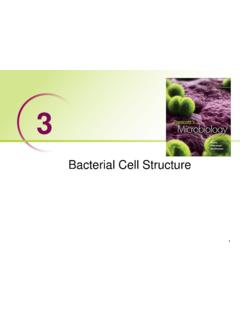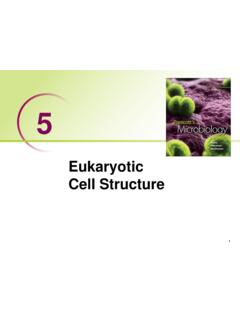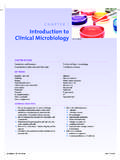Transcription of Bacterial Cell Structure - Bellarmine University
1 Bacterial Cell Structure 1 3 The Prokaryote Controversy the characteristics originally used to describe prokaryotic cells an opinion on the prokaryote controversy using current evidence about Bacterial cells 2 A Typical Bacterial Cell a typical Bacterial cell from a typical plant or animal cell in terms of cell shapes and arrangements, size, and cell structures the factors that determine the size and shape of a Bacterial cell. 3 4 Bacterial and Archaea Structure and Function Prokaryotes differ from eukaryotes in size and simplicity most lack internal membrane systems term prokaryotes is becoming blurred this text will use Bacteria and Archaea this chapter will cover Bacteria and their structures 5 Size, Shape, and Arrangement Shape cocci and rods most common various others Arrangement determined by plane of division determined by separation or not Size - varies 6 Shape and Arrangement-1 Cocci (s.)
2 , coccus) spheres diplococci (s., diplococcus) pairs streptococci chains staphylococci grape-like clusters tetrads 4 cocci in a square sarcinae cubic configuration of 8 cocci 7 Shape and Arrangement-2 bacilli (s., bacillus) rods coccobacilli very short rods vibrios resemble rods, comma shaped spirilla (s., spirillum) rigid helices spirochetes flexible helices 8 Shape and Arrangement-3 mycelium network of long, multinucleate filaments pleomorphic organisms that are variable in shape 9 10 Size smallest m (Mycoplasma) average rod - x 2 6 m (E. coli) very large 600 x 80 m Epulopiscium fishelsoni 11 Size Shape Relationship important for nutrient uptake surface to volume ratio (S/V) small size may be protective mechanism from predation 12 Bacterial Cell Organization Common Features Cell envelope 3 layers Cytoplasm External structures 13 Bacterial Plasma Membranes the fluid mosaic model of membrane Structure and identify the types of lipids typically found in Bacterial membranes.
3 Macroelements (macronutrients) from micronutrients (trace elements) and provide examples of each. examples of growth factors needed by some microorganisms. and contrast passive diffusion, facilitated diffusion, active transport, and group translocation, and provide examples of each. the difficulty of iron uptake and describe how bacteria overcome this difficulty. 14 15 Bacterial Cell Envelope Plasma membrane Cell wall Layers outside the cell wall 16 Bacterial Plasma Membrane Absolute requirement for all living organisms Some bacteria also have internal membrane systems 17 Plasma Membrane Functions Encompasses the cytoplasm Selectively permeable barrier Interacts with external environment receptors for detection of and response to chemicals in surroundings transport systems metabolic processes 18 Fluid Mosaic Model of Membrane Structure lipid bilayers with floating proteins amphipathic lipids polar ends (hydrophilic interact with water) non-polar tails (hydrophobic insoluble in water)
4 Membrane proteins 19 Membrane Proteins Peripheral loosely connected to membrane easily removed Integral amphipathic embedded within membrane carry out important functions may exist as microdomains 20 Bacterial Lipids Saturation levels of membrane lipids reflect environmental conditions such as temperature Bacterial membranes lack sterols but do contain sterol-like molecules, hopanoids stabilize membrane found in petroleum 21 Uptake of Nutrients Getting Through the Barrier Macroelements (macronutrients) C, O, H, N, S, P found in organic molecules such as proteins, lipids, carbohydrates, and nucleic acids K, Ca, Mg, and Fe cations and serve in variety of roles including enzymes, biosynthesis required in relatively large amounts 22 Uptake of Nutrients Getting Through the Barrier Micronutrients (trace elements) Mn, Zn, Co, Mo, Ni, and Cu required in trace amounts often supplied in water or in media components ubiquitous in nature serve as enzymes and cofactors Some unique substances may be required 23 Uptake of Nutrients Getting Through the Barrier Growth factors organic compounds essential cell components (or their precursors)
5 That the cell cannot synthesize must be supplied by environment if cell is to survive and reproduce 24 Classes of Growth Factors amino acids needed for protein synthesis purines and pyrimidines needed for nucleic acid synthesis vitamins function as enzyme cofactors heme 25 Uptake of Nutrients Microbes can only take in dissolved particles across a selectively permeable membrane Some nutrients enter by passive diffusion Microorganisms use transport mechanisms facilitated diffusion all microorganisms active transport all microorganisms group translocation Bacteria and Archaea endocytosis Eukarya only 26 Passive Diffusion Molecules move from region of higher concentration to one of lower concentration between the cell s interior and the exterior H2O, O2, and CO2 often move across membranes this way 27 Facilitated Diffusion Similar to passive diffusion movement of molecules is not energy dependent direction of movement is from high concentration to low concentration size of concentration gradient impacts rate of uptake 28 Facilitated Differs from passive diffusion uses membrane bound carrier molecules (permeases) smaller concentration gradient is required for significant uptake of molecules effectively transports glycerol, sugars, and amino acids more prominent in eukaryotic cells than in bacteria or archaea 29 30 Active Transport energy-dependent process ATP or proton motive force used move molecules against the gradient concentrates molecules inside cell involves carrier proteins (permeases) carrier saturation effect is observed at high solute concentrations 31 ABC Transporters Primary active transporters use ATP ATP-binding cassette (ABC)
6 Transporters Observed in Bacteria, Archaea, and eukaryotes Consist of - 2 hydrophobic membrane spanning domains - 2 cytoplasmic associated ATP-binding domains - Substrate binding domains 32 Secondary Active Transport Major facilitator superfamily (MFS) Use ion gradients to cotransport substances protons symport two substances both move in the same direction antiport two substances move in opposite directions 33 34 Group Translocation Energy dependent transport that chemically modifies molecule as it is brought into cell Best known translocation system is phosphoenolpyruvate: sugar phosphotransferase system (PTS) 35 36 Iron Uptake Microorganisms require iron Ferric iron is very insoluble so uptake is difficult Microorganisms secrete siderophores to aid uptake Siderophore complexes with ferric ion Complex is then transported into cell Bacterial Cell Walls peptidoglycan Structure . and contrast the cell walls of typical Gram-positive and Gram-negative bacteria.
7 Bacterial cell wall Structure to the Gram-staining reaction. 37 38 Bacterial Cell Wall Peptidoglycan (murein) rigid Structure that lies just outside the cell plasma membrane two types based on Gram stain Gram-positive: stain purple; thick peptidoglycan Gram-negative: stain pink or red; thin peptidoglycan and outer membrane 39 Cell Wall Functions Maintains shape of the bacterium almost all bacteria have one Helps protect cell from osmotic lysis Helps protect from toxic materials May contribute to pathogenicity 40 Peptidoglycan Structure Meshlike polymer of identical subunits forming long strands two alternating sugars N-acetylglucosamine (NAG) N- acetylmuramic acid alternating D- and L- amino acids 41 Strands Are Crosslinked Peptidoglycan strands have a helical shape Peptidoglycan chains are crosslinked by peptides for strength interbridges may form peptidoglycan sacs interconnected networks various structures occur 42 43 Gram-Positive Cell Walls Composed primarily of peptidoglycan May also contain teichoic acids (negatively charged)
8 Help maintain cell envelope protect from environmental substances may bind to host cells some gram-positive bacteria have layer of proteins on surface of peptidoglycan 44 45 Periplasmic Space of Gram + Bacteria Lies between plasma membrane and cell wall and is smaller than that of Gram-negative bacteria Periplasm has relatively few proteins Enzymes secreted by Gram-positive bacteria are called exoenzymes aid in degradation of large nutrients 46 Gram-Negative Cell Walls More complex than Gram- positive Consist of a thin layer of peptidoglycan surrounded by an outer membrane Outer membrane composed of lipids, lipoproteins, and lipopolysaccharide (LPS) No teichoic acids 47 Gram-Negative Cell Walls Peptidoglycan is ~5-10% of cell wall weight Periplasmic space differs from that in Gram-positive cells may constitute 20 40% of cell volume many enzymes present in periplasm hydrolytic enzymes, transport proteins and other proteins 48 Gram-Negative Cell Walls outer membrane lies outside the thin peptidoglycan layer Braun s lipoproteins connect outer membrane to peptidoglycan other adhesion sites reported 49 Lipopolysaccharide (LPS) Consists of three parts lipid A core polysaccharide O side chain (O antigen) Lipid A embedded in outer membrane Core polysaccharide, O side chain extend out from the cell 50 Importance of LPS contributes to negative charge on cell surface helps stabilize outer membrane Structure may contribute to attachment to surfaces and biofilm formation creates a permeability barrier protection from host defenses (O antigen)
9 Can act as an endotoxin (lipid A) 51 Gram-Negative Outer Membrane Permeability More permeable than plasma membrane due to presence of porin proteins and transporter proteins porin proteins form channels to let small molecules (600 700 daltons) pass 52 Mechanism of Gram Stain Reaction Gram stain reaction due to nature of cell wall shrinkage of the pores of peptidoglycan layer of Gram-positive cells constriction prevents loss of crystal violet during decolorization step thinner peptidoglycan layer and larger pores of Gram-negative bacteria does not prevent loss of crystal violet 53 Osmotic Protection Hypotonic environments solute concentration outside the cell is less than inside the cell water moves into cell and cell swells cell wall protects from lysis Hypertonic environments solute concentration outside the cell is greater than inside water leaves the cell plasmolysis occurs 54 Evidence of Protective Nature of the Cell Wall lysozyme breaks the bond between N-acetyl glucosamine and N-acetylmuramic acid penicillin inhibits peptidoglycan synthesis if cells are treated with either of the above they will lyse if they are in a hypotonic solution 55
10 cells that Lose a Cell Wall May Survive in Isotonic Environments Protoplasts Spheroplasts Mycoplasma does not produce a cell wall plasma membrane more resistant to osmotic pressure Cell Envelope Layers Outside the Cell Wall a list of all the structures found in all the layers of Bacterial cell envelopes, noting the functions and the major component molecules of each. 56 57 Components Outside of the Cell Wall Outermost layer in the cell envelope Glycocalyx capsules and slime layers S layers Aid in attachment to solid surfaces , biofilms in plants and animals 58 Capsules Usually composed of polysaccharides Well organized and not easily removed from cell Visible in light microscope Protective advantages resistant to phagocytosis protect from desiccation exclude viruses and detergents 59 Slime Layers similar to capsules except diffuse, unorganized and easily removed slime may aid in motility 60 S Layers Regularly structured layers of protein or glycoprotein that self-assemble in Gram-negative bacteria the S layer adheres to outer membrane in Gram-positive bacteria it is associated with the peptidoglycan surface 61 S Layer Functions Protect from ion and pH fluctuations, osmotic stress, enzymes.






